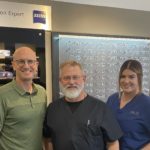
Dr. Fleming with two of his practice’s opticians. The added challenges of the Great Resignation prompted Dr. Fleming to revamp the practice’s process for recruiting and on-boarding new employees.
By Chad Fleming, OD, FAAO
August 17, 2022
Leading a small business through the challenges of survival in a competitive marketplace is hard. Here are the details on three big challenges I confronted as a practice owner and how I implemented solutions that improved care and preserved profitability.
Authenticity: Be Honest with Staff & Encourage Them to Be Honest with Patients
Some small business owners feel that if they share their mistakes it will create a culture of failure, prompting employees to leave. It’s human nature to not want to share your mistakes. Social media is full of, “Here’s what I am doing, and it is a reflection of the good in myself.” However, it’s important to talk about both what worked and what didn’t, and for the practice owner to be upfront about their own mistakes.
When the owner of a practice is open and honest with staff, staff model that behavior with patients. When our staff is authentic, patients respond by being more understanding and cooperative when bad things happen or inconveniences arise. They appreciate the honesty of an employee who explains what happened rather than trying to cover it up or lie about it.
We have two one-hour on-boarding “Discover Wichita Optometry” classes for new employees in which we emphasize the importance of authenticity. We reiterate that message every month in staff meetings. We discuss recent hits and misses, with both support staff and doctor/owners alike sharing thoughts on what could have been done better, even when those things relate to their own work.
How do you know if your quest for an authentic culture is successful? You will get more positive feedback. You might hear more patients talk about how much they like your people. Your practice may also start noticing employees showing their potential for growth. They will start improving with the help of honest conversations about strengths and weaknesses in the practice.
Authenticity comes easier for some people than others. You might need to enlist the help of a life coach or read a book like “Leaders Eat Last” by Simon Sinek. These resources will challenge you to look in the mirror and address the deeper issues of how you lead your practice. If your practice culture isn’t honest and authentic, it may be a reflection of your leadership style and the shortcomings of your communication style.
Maintaining Staff with Systematic Hiring
Encouraging loyal staff to remain with us, and finding new employees when necessary, was always hard, but became exponentially harder during the Great Resignation. The current challenge is akin to a football team that keeps getting close to the championship only to find before the big game that their quarterback decided to stop playing. You need a way of quickly finding a new quarterback.
People gravitate toward places in their community where they feel important, and long-term staff and doctors are the ones who make patients feel that way. However, in the environment we are currently in, retaining long-term employees is not always possible. While we value our long-term employees, and show them that by creating a friendly, respectful workplace, and offering competitive salaries, we have to confront what to do when those employees leave.
Turnover is costly. I have heard human resources experts say that the cost of hiring one new staff member can cost up to half of the cost of that new employee’s salary. It does not appear that it is that costly in an optometric practice, however, there is a significant cost to current staff members and doctors spending time every week in interviews with potential new employees and on new employee training.
We created new systems and updated some of our other systems to streamline the process of finding new employees. Our first two weeks of training a new staff member is now systematic and consistent for each new employee. New employees go through the on-boarding process, which includes reviewing our employment manual, doing HIPAA training, shadowing an employee who is doing the same work they will be doing, checking out a computer, getting signed on to software like our EHR and patient engagement software. They also participate in our Discover Wichita Optometry class.
Other Articles to Explore
We also automated the application process through Indeed, and we have first-round interviews via Zoom instead of in-person. We have even discussed requesting that an applicant send in a 30-60 second video of themselves telling us why we should consider them for an interview. This would quickly weed out those who are not serious.
If we did not systematize the process of finding new staff and getting them up to speed, we would have had to hire more staff to our HR department, which would have cut sharply into our profit margin. In addition to avoiding added expense, we are seeing happier managers, who do not experience as much stress about the hiring process.
Proactively create systems for future problems like the need to fill job slots. Too many of us wait until things fall apart and then we scramble at that point to find a solution. One thing the recruitment challenge has reinforced for me is the importance of working on your systems and processes for doing business, including how you hire people.
It currently takes us 2-4 weeks to fill open positions. Our staff retention rate used to be 90 percent, but over the past two years it fell to 70 percent. We are hopeful that the trends negatively impacting retention, such as the Great Resignation, are changing. However, we are now in a better position to confront this challenge with the new systems we put in place.
Automated Check-In & More Employee Time on Remote Communications
Over the past two years, people have grown more accustomed to communicating with companies via text, live chat, e-mail and social media. Companies in the current era have pivoted to automated communications. This need to pivot is no different for an optometric practice. Our company needed more staff on the phones and responding to text messages. We either had to hire more staff without immediately increasing revenues or we could solve the problem by repurposing staff.
We found that patients are much more frustrated now than in the past if they do not get an immediate response. Amazon and other online sellers have trained consumers to expect immediate interaction when a question is asked. We found that having a virtual staff member who can promptly reply is more important than having an additional staff member for face-to-face interactions at the office.
I prioritized by rank all patient touch points with our office. I asked myself the question, in today’s culture what are non-negotiable touch points and which could be considered replaceable or automated touch points? After doing this exercise I studied other businesses in both the service and product industry and studied those businesses that have already done the hard work of testing the concept.
I visited the Walmart store in Bentenville, Ark., which is usually a testing ground for future changes at Walmart. I noted that all live-person checkouts had been replaced with self-check-outs. After seeing that, I realized that we could do something similar in our practice’s offices, and that most patients would probably accept it, and even be happier with it than the old way of checking out. I created a virtual check-in at three of our five practice locations. This allowed me to move three employees, who previously worked at the front desk, to our digital communications team. This allowed me to keep the employees, but repurpose them based on our new needs. The transition required retraining patients to get them used to virtually checking in on an iPad when they arrive, but it did not result in any patient leaving because of this.
At first patients thought we had implemented automated check-in to get rid of staff. We reassured them that we were keeping the staff; just putting more of them on phones and text messaging, so that we could communicate more promptly with people who wanted to reach us that way. Patients then understood and appreciated this practice change.
We now have fewer missed phone calls or messages left on voicemail. I believe that adds up to improved patient care. The overall impact is we are a better company to do business with.
 Chad Fleming, OD, FAAO, is a partner with Wichita Optometry, P. A. in Wichita, Kan. To contact: chad@optometryceo.com
Chad Fleming, OD, FAAO, is a partner with Wichita Optometry, P. A. in Wichita, Kan. To contact: chad@optometryceo.com

























